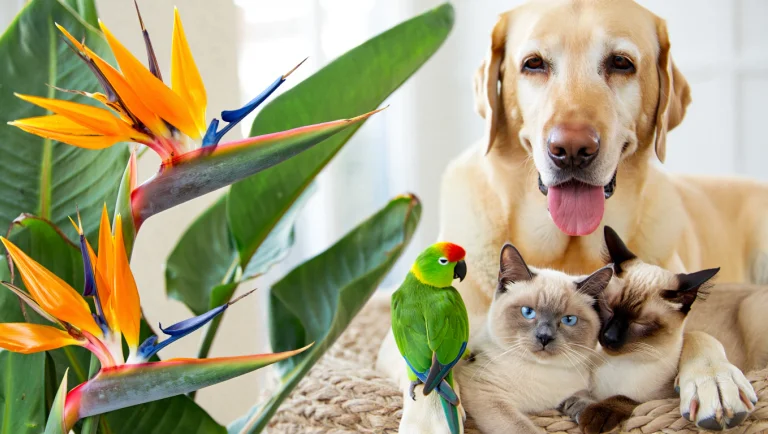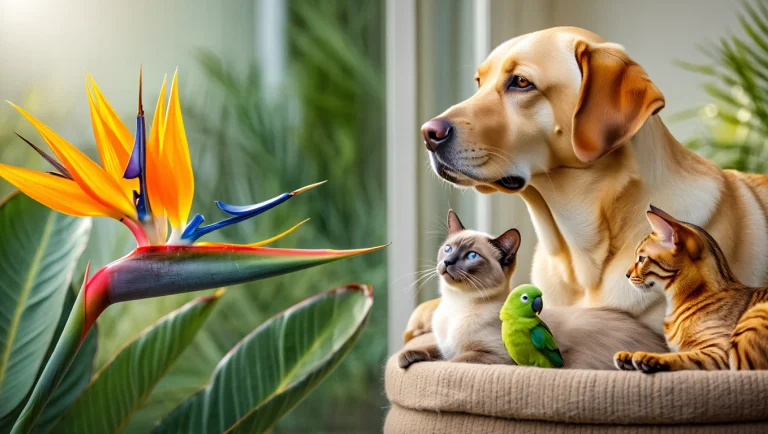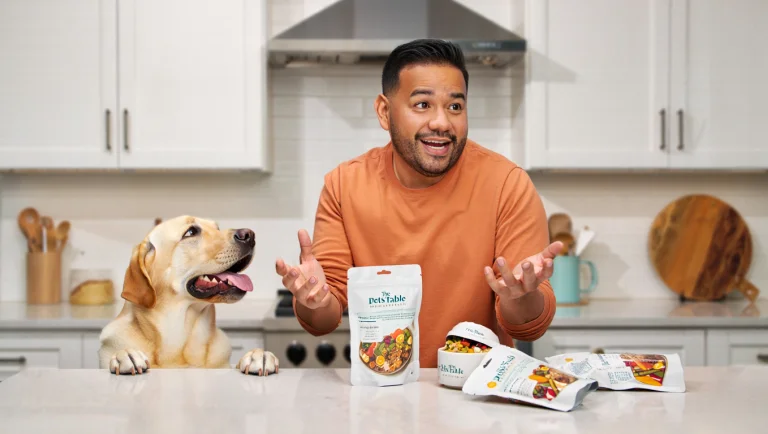Discover the 6 crucial things every pet owner needs to know about the bird of paradise plant, from toxicity levels to safety tips that protect your furry friends.
Table of Contents

As pet owners, we constantly strive to create a safe and nurturing environment for our furry companions. However, many common houseplants can pose unexpected dangers to our pets. The Bird of Paradise plant, known for its striking resemblance to a tropical bird in flight, is a popular decorative choice in many homes—but how safe is it for your four-legged family members?
This comprehensive guide explores everything pet owners need to know about the Bird of Paradise plant, from its toxicity levels to practical tips for keeping your pets safe while still enjoying this beautiful botanical specimen in your home.
What is a Bird of Paradise Plant?
The Bird of Paradise (Strelitzia species) is a stunning tropical plant native to South Africa. With its large, paddle-shaped leaves and unique, crane-like flowers in vibrant orange, blue, and white, it’s easy to see why this plant has become a favorite among indoor plant enthusiasts and landscapers alike.
There are primarily two varieties commonly found in homes and gardens:
- Strelitzia reginae: The classic Bird of Paradise, growing 3-5 feet tall with the iconic bird-shaped flowers
- Strelitzia nicolai: Also known as the Giant White Bird of Paradise, growing up to 20-30 feet tall with white and blue flowers
Both varieties make striking statement pieces in homes and gardens—but before you bring one into a household with pets, there are crucial safety considerations to keep in mind.
1. Toxicity Levels: Is Bird of Paradise Poisonous to Pets?
The bird of paradise plant contains compounds that can be harmful when ingested by pets. Understanding the specific toxicity concerns is essential for responsible pet ownership.
Toxic Components
The plant contains several toxic compounds, including:
- Hydrocyanic acid: Present in the seeds and fruits
- Tannins: Found throughout the plant
- Gastrointestinal irritants: Concentrated in the flowers and leaves
Toxicity by Pet Type
Different pets may react differently to bird of paradise plant exposure:
Dogs: The ASPCA lists the bird of paradise plant as toxic to dogs. Ingestion can cause mild to moderate symptoms, including:
- Nausea and vomiting
- Drowsiness
- Difficulty swallowing
- Drooling
- Abdominal pain
Cats: Cats are particularly susceptible to plant toxicity due to their grooming habits and curiosity. Symptoms in cats may include:
- Excessive drooling
- Pawing at the mouth
- Vomiting
- Diarrhea
- Lethargy
Small Pets: For rabbits, guinea pigs, hamsters, and other small mammals, the bird of paradise plant can cause:
- Digestive upset
- Loss of appetite
- Lethargy
- Potential respiratory issues
According to a study published in the Journal of Veterinary Medicine, approximately 8% of plant toxicity cases in pets involve ornamental houseplants like the bird of paradise. Dr. Elizabeth Warren, a veterinary toxicologist, notes: “While the bird of paradise plant isn’t among the most lethal plants for pets, its attractive appearance and accessibility can make it a common culprit in mild to moderate toxicity cases.”

2. Symptoms of Bird of Paradise Plant Poisoning in Pets
Recognizing the signs of poisoning early can make a significant difference in treatment outcomes. Here’s what to watch for if you suspect your pet has ingested parts of a bird of paradise plant:
Common Symptoms
- Oral irritation: Excessive drooling, pawing at the mouth, or visible discomfort when eating
- Gastrointestinal distress: Vomiting, diarrhea, or abdominal pain
- Behavioral changes: Lethargy, depression, or unusual agitation
- Decreased appetite: Refusing food or treats
- Increased thirst: Drinking more water than usual
Severe Cases
In rare but severe cases, additional symptoms may include:
- Difficulty breathing: Especially if airway irritation or swelling occurs
- Irregular heartbeat: Though uncommon, cardiac symptoms may present in severe cases
- Weakness or collapse: Indicating potential systemic effects
Timeline of Symptoms
Symptoms typically develop within a few hours of ingestion:
- 30 minutes to 2 hours: Initial oral irritation and drooling
- 2-6 hours: Gastrointestinal symptoms develop
- 6-24 hours: Symptoms usually peak and begin to resolve with appropriate treatment
According to the Pet Poison Helpline, approximately 75% of pets who ingest bird of paradise plant materials show mild to moderate symptoms that resolve within 24-48 hours with proper treatment. However, the severity can depend on the amount ingested and the specific part of the plant consumed.
Case Study: Max the Labrador Retriever In 2023, the Veterinary Emergency Clinic of Portland documented the case of Max, a 2-year-old Labrador who chewed on several bird of paradise leaves. Within 4 hours, Max developed drooling and vomiting. After receiving supportive care including IV fluids and anti-nausea medication, Max made a full recovery within 36 hours.
3. What to Do if Your Pet Ingests Bird of Paradise
If you suspect your pet has ingested any part of a bird of paradise plant, prompt action is crucial. Follow these steps to ensure your pet receives proper care:
Immediate Actions
- Remove the plant: Take your pet away from the plant to prevent further ingestion
- Check for plant material: Look for chewed leaves, stems, or flowers in and around your pet’s mouth
- Do not induce vomiting: Never attempt to make your pet vomit unless specifically instructed by a veterinarian
- Collect evidence: If possible, take photos of the plant and note which parts your pet may have consumed
Contacting a Veterinarian
- Call your vet immediately: Even if symptoms seem mild, professional guidance is essential
- Provide details: Tell them:
- Which part of the plant was ingested
- How much was consumed (if known)
- When the ingestion occurred
- What symptoms your pet is showing
- Your pet’s weight and any existing health conditions
Emergency Information to Have Ready
Keep these numbers accessible for emergencies:
- Your regular veterinarian: [insert space for reader to add]
- Nearest 24-hour emergency vet clinic: [insert space for reader to add]
- ASPCA Animal Poison Control: (888) 426-4435 (Note: a consultation fee may apply)
- Pet Poison Helpline: (855) 764-7661 (Note: a consultation fee may apply)
Dr. James Hernandez, emergency veterinarian at California Pet Medical Center, advises: “Time is of the essence in plant toxicity cases. Even if you’re unsure about the amount ingested, it’s always better to err on the side of caution and seek veterinary advice promptly.”
Treatment Options
Treatment typically focuses on managing symptoms and may include:
- Gastric decontamination: In recent ingestions, the veterinarian may induce vomiting or administer activated charcoal
- Fluid therapy: To prevent dehydration from vomiting and diarrhea
- Antiemetics: Medication to control nausea and vomiting
- Pain management: For gastrointestinal discomfort
- Monitoring: Observation for developing symptoms, especially in the first 24 hours
A 2022 report from the American Veterinary Medical Association noted that approximately 90% of pet plant toxicity cases have positive outcomes when veterinary care is sought within the first 4 hours of ingestion.
4. Safe Alternatives to Bird of Paradise for Pet Owners
If you’re a plant enthusiast with pets at home, you may want to consider pet-friendly alternatives that offer similar aesthetic appeal without the toxicity concerns.
Pet-Safe Plants with Similar Visual Impact
- Parlor Palm (Chamaedorea elegans)
- Features: Lush, tropical appearance with feathery fronds
- Pet safety: Non-toxic to dogs and cats
- Care level: Easy to moderate
- Boston Fern (Nephrolepis exaltata)
- Features: Graceful, arching fronds create a cascading effect
- Pet safety: Safe for all pets
- Care level: Moderate (requires consistent humidity)
- Areca Palm (Dypsis lutescens)
- Features: Tall, architectural presence with feathery fronds
- Pet safety: Non-toxic to cats and dogs
- Care level: Moderate
- Calathea varieties
- Features: Striking leaf patterns and colors
- Pet safety: Non-toxic to pets
- Care level: Moderate to challenging (requires humidity)
- Spider Plant (Chlorophytum comosum)
- Features: Arching variegated leaves with “spiderettes”
- Pet safety: Safe for pets (though may cause mild stomach upset if consumed in large quantities)
- Care level: Easy
Creating Pet-Safe Plant Displays
For those who still wish to keep bird of paradise plants:
- Dedicated plant room: Consider designating a room that remains inaccessible to pets for housing toxic plants
- Hanging planters: Place plants well out of reach, ensuring no leaves or flowers can fall within pet access
- Terrarium enclosures: Glass enclosures can showcase plants while keeping them separated from curious pets
According to interior designer and pet safety advocate Miranda Chen: “With thoughtful placement and proper boundaries, many pet owners successfully incorporate statement plants like bird of paradise into their homes. The key is creating physical separation that accounts for your specific pet’s habits and capabilities.”
5. Safe Placement and Pet Deterrent Strategies
If you decide to keep a bird of paradise plant in your pet-friendly home, strategic placement and deterrent methods can help minimize risks.
Optimal Placement Guidelines
- Elevated locations:
- High shelves (ensure stability)
- Plant stands at least 4 feet tall
- Wall-mounted planters
- Consider cat jumping heights (typically 5-6 feet)
- Separate spaces:
- Sunrooms with doors that can be closed
- Screened porches
- Office spaces where pets don’t have access
- Garden areas with physical barriers
- Consider pet habits:
- Observe where your pet spends most time
- Note paths they typically travel through your home
- Account for climbing abilities (especially for cats)
Effective Pet Deterrents
- Physical barriers:
- Plant cages or decorative fences
- Clear acrylic plant guards
- Decorative rocks as soil covers (preventing digging)
- Double-sided tape around plant areas (cats typically dislike the texture)
- Scent deterrents:
- Citrus peels placed around the plant base (many pets dislike citrus scents)
- Commercial pet repellent sprays (use only pet-safe products)
- Diluted vinegar spray on surfaces near plants (not on the plant itself)
- Behavior training:
- Positive reinforcement when pets ignore plants
- Consistent “leave it” command training
- Providing alternative items for pets to interact with
Technology Solutions
- Motion-activated deterrents: Devices that emit a harmless burst of air when motion is detected
- Plant monitoring cameras: Allow you to check on plant areas when you’re away
- Smart planters: Some newer models include built-in pet deterrent features
A survey conducted by the American Pet Products Association found that 68% of pet owners who successfully maintained potentially harmful plants used a combination of at least two deterrent strategies, with physical barriers and training being the most effective combination.
6. Creating a Comprehensive Pet Safety Plan for Plant Owners
Beyond addressing specific plants like the bird of paradise, a holistic approach to pet and plant coexistence ensures a safer environment for your animal companions.
Complete Home Plant Audit
- Inventory all plants:
- Document every plant in your home
- Research each for pet toxicity using resources like the ASPCA Plant List
- Label plants (discreetly) with toxicity level for quick reference
- Categorize by risk level:
- High-risk: Highly toxic (lilies, sago palm, etc.)
- Medium-risk: Moderately toxic (bird of paradise, philodendron, etc.)
- Low-risk: Mild irritants if consumed
- Safe: Non-toxic to pets
- Create a plant safety map:
- Diagram of your home showing plant locations
- Highlight high-risk areas
- Note locations of pet-safe plants
- Keep with emergency information
Pet Monitoring and Training
- Observation period:
- When introducing new plants, closely monitor pet behavior for the first week
- Watch for signs of interest in the plant
- Document any attempts to interact with the plant
- Distraction techniques:
- Provide pet-safe plants they can interact with
- Create dedicated pet spaces with engaging toys
- Consider pet grass or catnip gardens as alternatives
- Environmental enrichment:
- Ensure pets have adequate stimulation to reduce plant interest
- Regular exercise to minimize destructive behaviors
- Interactive toys that stimulate natural behaviors
Emergency Preparedness
- Create an emergency kit:
- List of all plants in your home with toxicity information
- Pet medical records
- Veterinarian and pet poison hotline contacts
- Basic first aid supplies
- Establish an action plan:
- Step-by-step protocol for suspected plant ingestion
- Transportation plan to emergency vet
- Designated person responsible for pet care in emergencies
- Regular updates:
- Review plant inventory quarterly
- Update emergency contacts as needed
- Refresh training for all household members annually
Veterinary behaviorist Dr. Lisa Radosta recommends: “Prevention is always more effective than reaction. Creating a systematic approach to plant safety gives pet owners peace of mind and significantly reduces risks of accidental poisoning incidents.”
The Bird of Paradise and Special Pet Considerations
Different pets may interact with plants in unique ways. Understanding these specific considerations can help you further customize your approach to plant safety.
Dogs and Bird of Paradise
Dogs are often attracted to plants through scent and may be more likely to chew on lower portions of plants. Consider these dog-specific tips:
- Place bird of paradise plants on surfaces dogs cannot reach or behind baby gates
- Provide appropriate chew toys to satisfy natural chewing instincts
- Be especially vigilant with puppies who explore through mouthing
- Consider bitter apple spray on lower plant containers (not the plant itself)
Cats and Bird of Paradise
Cats present unique challenges due to their climbing abilities and attraction to movement:
- Secure tall plants like bird of paradise so they cannot be tipped over
- Be mindful that falling leaves or flowers may become play objects
- Create designated “cat gardens” with safe plants like cat grass
- Consider motion-activated deterrents specifically designed for cats
Small Pets and Bird of Paradise
For households with rabbits, guinea pigs, or other small mammals:
- Ensure exercise areas are completely free of access to plants
- Be mindful that dropped leaves outside of cages can be reached
- Consider that these animals often have sensitive respiratory systems
- Provide ample safe foraging alternatives like timothy hay and safe greens
FAQs About Bird of Paradise Plants and Pet Safety
Is the bird of paradise plant fatal to pets if ingested?
While bird of paradise plants contain toxic compounds, fatalities are extremely rare. The plant is classified as mildly to moderately toxic, typically causing gastrointestinal symptoms rather than life-threatening conditions. However, any suspected ingestion should be treated as an emergency, as individual reactions can vary based on the pet’s size, health status, and amount consumed.
Which part of the bird of paradise plant is most toxic to pets?
The seeds and seed pods contain the highest concentration of toxic compounds, including hydrocyanic acid. However, all parts of the plant—including leaves, flowers, and stems—contain irritants that can cause adverse reactions in pets if ingested. The large size of bird of paradise leaves makes them particularly accessible to curious pets.
How can I tell if my pet has eaten part of my bird of paradise plant?
Signs your pet may have ingested bird of paradise include chewed or missing parts of the plant, plant material in or around your pet’s mouth, sudden onset of drooling, pawing at the mouth, vomiting, diarrhea, or lethargy. Some pets may also show signs of oral irritation such as reluctance to eat or drink. If you notice any of these symptoms alongside evidence of plant disturbance, contact your veterinarian immediately.
Can I keep a bird of paradise plant if I have pets?
Yes, many pet owners successfully maintain bird of paradise plants by implementing appropriate safety measures. Strategic placement beyond pet reach, consistent training, and supervision are key factors. Consider your specific pet’s habits and temperament—some pets show no interest in plants, while others are determined to investigate or chew on them regardless of deterrents.
Are artificial bird of paradise plants a good alternative for pet owners?
High-quality artificial bird of paradise plants can provide the same aesthetic appeal without toxicity concerns. Modern silk and polyester options look remarkably realistic. However, be aware that some pets may still chew on artificial plants, which can pose choking hazards or cause intestinal blockages if pieces are ingested. Secure artificial plants and monitor for signs of deterioration.
How quickly should I seek veterinary care if my pet ingests bird of paradise?
Veterinary care should be sought immediately upon suspicion of ingestion, even if symptoms haven’t yet appeared. Early intervention can significantly reduce the severity of symptoms and prevent complications. Contact your veterinarian or an emergency pet poison hotline for guidance based on your specific situation.
For more expert pet care tips and product recommendations, visit BlithePet.com — your trusted source for pet wellness.
Conclusion: Creating a Pet-Safe Plant Environment
Living with both pets and plants is absolutely achievable with the right knowledge and precautions. The bird of paradise plant, while moderately toxic to pets, can still be enjoyed in pet households when proper safety measures are implemented.
Remember these key takeaways:
- Know the risks: Understanding the specific toxicity of the bird of paradise plant empowers you to make informed decisions.
- Recognize symptoms: Early identification of poisoning symptoms allows for prompt treatment and better outcomes.
- Have a plan: Knowing exactly what to do if ingestion occurs can make a critical difference in an emergency.
- Consider alternatives: Pet-safe plants can provide similar visual impact without the worry.
- Use strategic placement: Thoughtful positioning and deterrents can create harmonious pet-plant coexistence.
- Develop a holistic approach: A comprehensive pet safety plan addresses all plants in your home.
By balancing your love for beautiful houseplants like the bird of paradise with your commitment to pet safety, you can create a thriving, harmonious home environment that nurtures both your botanical interests and your beloved animal companions.
Have a similar experience with your pet? Share it in the comments below!







